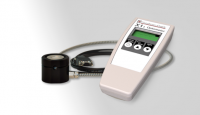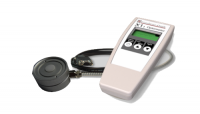This product is no longer manufactured. Remaining stock may still be available. Please refer to the alternatives listed below under "Similar products" or contact us directly.
Alternative Products for this discontinued product:
X1-UV-3727
UV radiometer for 222 nm Excimer, UV-C LEDs and germicidal lamps
- Calibration factors for excimer lamps at 222nm, UV LEDs from 220 nm to 300 nm and low pressure Hg lamps at 254nm
- Displays irradiance and dose with peak-hold function
- Pre-aging for long time stability
- Cosine field-of-view
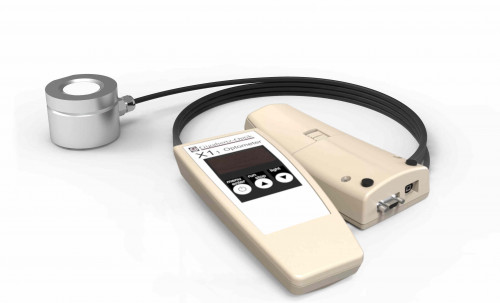
Germicidial UV Irradiation moving Deeper in the UV-C Region
Germicidal UV irradiation is a sterilization method that uses short wavelength light in the UV-C region (100 nm to 400 nm) to break down microorganisms such as viruses, bacteria, yeasts and fungi. Most commonly, low pressure mercury lamps emitting at 254nm have been used and more recently, UV LEDs emitting in the 265 nm to 290 nm are being employed. However, the widespread use of these conventional UVC light sources is somewhat limited as they have strong carcinogenic and cataractogenic effects.
Far-UVC light, for example 222 nm produced by Kr-Cl excimer lamps, has been shown to effectively inactivate bacteria, but with less photobiological hazard for humans. This is because far-UVC light cannot penetrate human skin or eyes as deeply as longer wavelength UV radiation.
To ensure the germicidal effect of any UVC light source, the UV dose must be checked. This is achieved by measuring the UV irradiance at the location of exposure using a UV radiometer. It is essential that the radiometer is suitably calibrated for the type of UV source to be measured.
UV-3727 Irradiance Detector
for 222nm excimer lamps, UVC LEDs and low-pressure Hg lamps
The UV-37 series detectors are specially designed for radiometric measurements in the UV spectral region and have been proven in industrial and scientific use over many years. The UV-3727 model provides the particular capability of measuring 222nm excimer lamps (Kr-Cl) typically used for germicidal applications. Additionally, it enables the measurement of other UVC germicidal source types including low pressure Hg lamps and UV LEDs.
The UV-3727 detector incorporates a photodiode that has extended deep-UV responsivity. Only radiation in the required spectral sensitivity range is measured (Figure 2). In addition to its calibration at 222nm, selectable calibration factors for common UV LED wavelengths and low-pressure Hg lamps are included.
To measure the irradiance, the detector’s entrance optic is a diffuser with a cosine field of view, which must be positioned in the desired plane of measurement. The diffuser and photodiode are pre-aged with UV radiation to significantly reduce the inevitable aging process that results from exposure to UV radiation. The UV-3727 detector shows very little aging effects even in intensive use. Any changes are recorded and corrected as part of the recommended annual recalibration.
The photodiode of the UV-3727 detector offers a strictly linear relationship between the measurement signal and the irradiance in the range from a few pico amps (10-12 A) to several micro amps (10-6 A). When connected to the Gigahertz-Optik X1 meter (Figure 1) it provides a linear measurement range up to at least 1000 mW / cm² with a resolution of 0.002µW / cm² (@222 nm).
For more details see the product page of the UV-3727 detector.
Traceable Calibration by our Calibration Laboratory
Reliable measurements in absolute units require the calibration of the measuring device with traceability to national metrological institute (NMI) standards. Since 1993, the Gigahertz-Optik measuring laboratory has been accredited as a calibration laboratory by the PTB (Physikalisch-Technische Bundesanstalt) and the DAkkS (German Accreditation Body) for the measurement of spectral responsivity and spectral irradiance (D-K-15047-01-00). Since then, all factory calibrations have been closely based on the calibration standards and quality management of the accredited calibration laboratory. Therefore, the factory calibrations of Gigahertz-Optik offer the highest possible level of traceability and are accepted worldwide.
In accordance with the requirements of individual industrial sectors, part of the calibration laboratory is accredited as a DIN EN ISO / IEC 17025 test laboratory by the DAkkS (D-PL-15047-01-00). As a result, Gigahertz-Optik can optionally offer a DIN EN ISO / IEC 17025 test certificate for the calibration of the X1-UV-3727 in addition to the factory certificate.
The UV-3727 detector is calibrated for its spectral responsivity. When performing a measurement, either the 222nm excimer wavelength or the nominal wavelength of the UV-LED or Hg lamp can be selected on the X1-1 meter.
Measuring device X1
The X1 measuring device evaluates the signal from the UV-3727 detector and displays the measured irradiance in absolute units, mW / cm². The high-quality signal amplifier of the meter supports the very large dynamic range of the detector with 7 decades of gain ranges. In addition to irradiance, the dose can be displayed in mJ / cm². The measuring device offers a ‘peak-hold’ display function. The ergonomic housing of the device with its two AA batteries supports mobile use. Alternatively, the measuring device can be operated via its USB interface with the available application software for PCs. A software development kit (SDK) enables the measurement device to be integrated into user-written software.
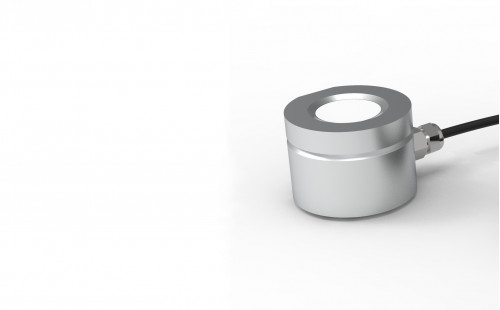
UV-3727
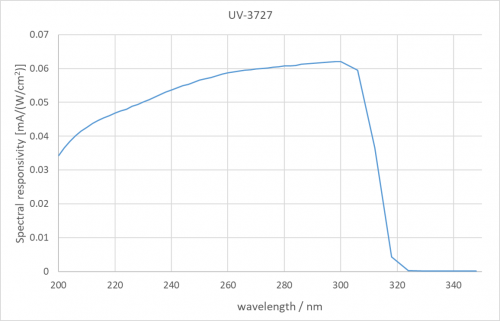
Typical spectral sensitivity of the UV-3727 detector shown.
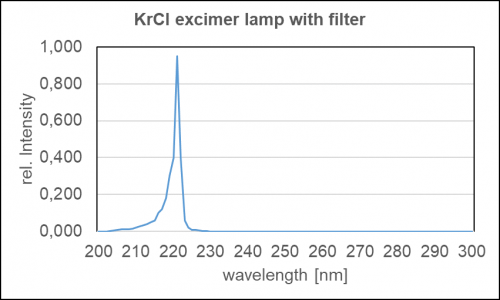
Typical spectral power distribution of Kr-Cl excimer lamp with filter used for germicidal applications.
Typical field of view with good cosine correction
Similar Products
Product Categories
